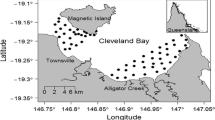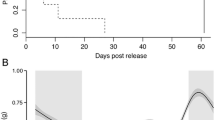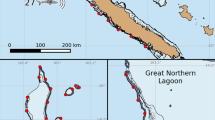Abstract
Previous work on white sharks indicate the species show seasonally limited movement patters, at certain aggregation sites small areas may play vital roles in the life history of a large amount of the population. Acoustic telemetry was used to estimate habitat use of white sharks, Carcharodon carcharias, while aggregating at Mossel Bay, South Africa. Total range of all shark tracks combined accumulated 782 h and covered an area of 93.5 km2 however, within this range, sharks were found to highly utilise a core habitat (50 % Kernel, K50) of just 1.05 km2 over a reef system adjacent to a river mouth. Individual tracks revealed additional core habitats, some of which were previously undocumented and one adjacent to a commercial harbor. Much was found to be dependent on the size of the shark, with larger sharks (>400 cm) occupying smaller activity areas than subadult (300–399 cm) and juvenile (<300 cm) conspecifics, while Index of Reuse (IOR) and Index of Shared Space (IOSS) were both found to increase with shark size. Such results provide evidence that larger white sharks are more selective in habitat use, which indicates they have greater experience within aggregation sites. Furthermore, the focused nature of foraging means spatially restricted management strategies would offer a powerful tool to aid enforcement of current protective legislation for the white shark in similar environments of limited resources and capacity.






Similar content being viewed by others
References
Baum JK, Myers RA, Kehler DC, Worm B, Harley SJ, Doherty PA (2003) Collapse and conservation of sharks in the Northwest Atlantic. Science 299:389–392
Bell WJ, Kramer E (1979) Search and anemotactic orientation of cockroaches. J Insect Physiolo 25:631–640
Bonfil R, Meyër M, Scholl MC, Johnson R, O’Brien S, Oosthuizen H, Swanson S, Kotze D, Paterson M (2005) Transoceanic migration, spatial dynamics, and population linkages of white sharks. Science 310:100–103
Bruce AD (1992) Preliminary observations on the biology of the white shark, Carcharodon carcharias, in South Australian Waters. Aust J Mar Freshwat Res 43:1–11
Bruce BD, Stevens JD, Bradford RW (2005) Site fidelity, residence times and home range patterns of white sharks around pinniped colonies. Final Report to the Australian Government Department of the Environment and Heritage – June 2005.
Bruce BD, Stevens JD, Malcolm H (2006) Movements and swimming behaviour of white shark (Carcharodon carcharias) in Australian waters. Mar Biol 150:161–172
Bull CM, Baghurst BC (1998) Home range overlap of mothers and their offspring in the sleepy lizard, Tiliqua rugosa. Behav Ecol Sociobio 42:357–362
Burt WH (1943) Territory and home range concepts as applied to mammals. J Mammal 24:346–352
Carr AP, Rogers AR (1998) HRE: the home range extension for ArcView™ (Beta Test Version 0.9, July 1998) Tutorial Guide
Compagno LJV (1991) Government protection for the great white shark (Carcharodon carcharias ) in South Africa. S Afri J Sci 87:284–285
Compagno LJV, Marks MA, Fergusson IK (1997) Threatened fishes of the world - Carcharodon carcharias (Linnaeus, 1758) (Lamnidae). Envi Biol Fish 50:61–62
Cooper WE (1978) Home range criteria based on temporal stability of areal occupation. J Theo Biol 73:687–695, Cited in Morrissey and Gruber 1993
Dudley SFJ, Simpfendorfer CA (2006) Population status of 14 shark species caught in the protective gillnets off KwaZulu-Natal beaches, South Africa, 1978–2003. Mar Freshwat Res 57(2):225–240
Duffy CAJ, Francis MP, Manning M, Bonfil R (2012) Regional population connectivity, oceanic habitat and return migration revealed by satellite tagging of white sharks (Carcharodon carcharias) at New Zealand aggregation sites. In: Domeier ML (ed) Global perspectives on the biology and life history of the Great White Shark (Carcharodon carcharias) Ch. 21:301–319. CRC Press, Boca Raton
Dulvy N, Baum JK, Clarke S, Compagno LVJ, Cortés E, Domingo A, Fordham S, Fowler S, Francis MP, Gibson M, Martínez J, Musick JA, Soldo A, Stevens JD, Valenti S (2008) You can swim but you can’t hide: the global status and conservation of oceanic pelagic sharks and rays. Aqua Conserve Mar Freshwat Ecosyst 18:459–482
Estrada JA, Rice AN, Natanson LJ, Skomal GB (2006) Use of isotopic analysis of vertebrae in reconstructing ontogenetic feeding ecology in white sharks. Ecology 87(4):829–834
Fergusson I, Compagno LJV, Marks M (2005) Carcharodon carcharias. In: IUCN 2010. IUCN Red List of Threatened Species. Version 2010.4
Ferrara TL, Clausen P, Huber DR, McHenry CR, Peddemors V, Wroe S (2011) Mechanics of biting in great white and sandtiger sharks. J Biomech 44:430–435
Gallagher A, Hammerschlag N (2011) Global shark currency: the distribution, frequency, and economic value of shark ecotourism. Curr Issues Tourism iFirst Article 1–6. doi:10.1080/13683500.2011.585227
Goldman KJ, Anderson SD (1999) Space utilisation and swimming depth of white shark (Carcharodon carcharias) at the South Farallon Islands, central California. Environ Biol Fish 56:351–364
Gruber SH, Nelson DR, Morrissey JF (1988) Patterns of activity and space utilization of lemon sharks, Negaprion brevirostris, in a shallow Bahamian lagoon. Bull Mar Sci 43:61–76
Hearn A, Ketchum J, Klimley AP, Espinoza E, Penaherrera C (2010) Hotspots within hotspots? Hammerhead shark movements around Wolf Island, Galapagos Marine Reserve. Mar Biol 157:1899–1915
Heupel MR, Simfendorfer CA (2005) Using acoustic monitoring to evaluate MPAs for shark nursery areas: the importance of long term data. Mar Tech Soc J 39:10–18
Heupel MR, Simpfendorfer CA, Hueter RE (2004) Estimation of shark home ranges using passive monitoring techniques. Environ Biol Fish 71:135–142
Hooge PN, Eichenlaub B (2000) Animal movement extension to Arcview. ver. 2.0. Alaska Science Center—Biological Science Office, U.S. Geological Survey, Anchorage, AK, USA
Jewell OJD, Wcisel MA, Gennari E, Towner AV, Bester MN, Johnson RL, Singh S (2011) Effect of Smart Position Only Tag (SPOT) deployment on white sharks (Carcharodon carcharias) in South Africa. PLoS One 6(11):e27242
Johnson RL (2003) Behavioural ecology of the white shark (Carcharodon carcharias) at Dyer Island, South Africa. MSc Thesis, University of Pretoria, Pretoria, South Africa
Johnson R (in prep.) Behavioural ecology of white sharks at Mossel Bay. PhD thesis, University of Pretoria, South Africa
Johnson R, Kock A (2006) South Africa’s White Shark cage-diving industry—is there cause for concern? In: Nel DC, Peschak TP (eds) Finding a balance, WWF South Africa Report Series—2006/Marine/001:40–59
Johnson R, Bester MN, Dudley SFJ, Oosthuizen WH, Meÿer M, Hancke L, Gennari E (2009) Coastal swimming patterns of white sharks (Carcharodon carcharias) at Mossel Bay, South Africa. Environ Biol Fish 85:189–200
Jorgensen SJ, Reeb CA, Chappel TK, Anderson S, Perle C, Van Sommeran SR, Fritz-Cope C, Brown AC, Klimley AP, Block BA (2010) Philopatry and migration of Pacific white sharks. Proc R Soc Biol. doi:10.1098/rspb.2009.1155
Jorgensen JS, Chappel TK, Anderson S, Hoyos M, Reeb CA, Block BA (2012) Connectivity among white shark coastal aggregation areas in the Northeastern Pacific. In: Domeier ML (ed) Global perspectives on the biology and life history of the great white shark (Carcharodon carcharias), Ch. 13:159–168. CRC Press, Boca Raton
Kirkman S (pers. comm.) Department of Environmental Affairs, Oceans and Coasts, Cape fur seal population on Seal Island, Mossel Bay.
Klimley PA, Le Boeuf BJ, Cantara KM, Richert JE, Davis SF, Van Sommeran S (2001) Radio acoustic positioning tool for studying site-specific behaviour of white sharks and other large marine species. Mar Biol 138:429–446
Kock A, Johnson, R (2006) White shark abundance: Not a causative factor in numbers of shark bite incidences. In: Nel DC, Peschak TP (eds) Finding a balance: White shark conservation and recreational safety in inshore waters of Cape Town, South Africa: Proceedings of a specialist workshop. WWF South Africa Report Series - 2006/Marine/001:1–19
Kock A, Titley S, Peterson W, Sikweyiya M, Tsotsobe S, Colenbrander D, Gold H, Oelofse G (2012) Shark spotters: A pioneering shark safety program in Cape Town, South Africa. In: Domeier ML (ed) Global perspectives on the biology and life history of the great white shark (Carcharodon carcharias), Ch. 29:447–467. CRC Press, Boca Raton
McCord ME, Lamberth SJ (2009) Catching and tracking the world’s largest Zambezi (bull) shark Carcharhinus leucas in the Breede Estuary, South Africa: the first 43 h. Afr J Mar Sci 31(1):107–111
McKibben JN, Nelson DR (1986) Patterns of movement and grouping of gray reef sharks, Carcharhinus amblyrhynchos, at Enewetak, Marshall Islands. Bull Mar Sci 38:89–110, Cited in Morrissey and Gruber 1993
McNab BK (1963) Bioenergetics and the determination of home range size. Am Nat 97:133–140
Meyer CG, Holland KN (2005) Movement patterns, home range size and habitat utilization of the bluespine unicornfish, Naso unicornis (Acanthuridae) in a Hawaiian marine reserve. Environ Biol Fish 73:201–210
Morrissey JF, Gruber SH (1993) Home range of juvenile lemon sharks, Negaprion brevirostris. Copeia 1993:425–434
Nasby-Lucas N, Dewar H, Lam CH, Goldman KJ, Domeier ML (2009) White shark offshore habitat: a behavioral and environmental characterization of the Eastern Pacific shared offshore foraging area. PLoS One 4:e8163
Peschak T (2006) Sharks and Shark Bite in the Media. In Nel DC, Peschak TP (eds) Finding a balance: White shark conservation and recreational safety in inshore waters of Cape Town, South Africa: Proceedings of a specialist workshop., WWF South Africa Report Series—2006/Marine/001:159–163.
Rechisky EL, Weatherbee BM (2003) Short-term movements of juvenile and neonate sandbar sharks, Carcharhinus plumbeus, on their nursery grounds in Delaware Bay. Environ Biol Fish 68:113–128
Shivji MS, Chapman DD, Pikitch EK, Raymond PW (2005) Genetic profiling reveals illegal international trade in fins of the great white shark, Carcharodon carcharias. Conserv Genet 6:1035–1039
Silverman BW (1986) Density estimation for statistics and data analysis. Chapman & Hall/CRC, Boca Raton
Simpfendorfer CA, Wiley TA, Yeiser BG (2010) Improving conservation planning for an endangered sawfish using data from acoustic telemetry. Biol Conserv 143:1460–1469
Smale M, Cliff G (2012) White sharks and cephalopod prey: indicators of habitat use? In: Domeier ML (ed) global perspectives on the biology and life history of the great white shark (Carcharodon carcharias) Ch. 4:51–59. CRC Press, Boca Raton
Sundström LF, Gruber SH, Clermont SM, Correia JPS, de Marignac JRC (2001) Review of elasmobranch behavioural studies using ultrasonic telemetry with special reference to the lemon shark, Negaprion brevirostris, around Bimini Islands, Bahamas. Environ Biol Fish 60:225–250
Teo SLH, Boustany A, Blackwell S, Walli A, Weng KC, Block BA (2004) Validation of geolocation estimates based on light level and sea surface temperature from electronic tags. Mar Ecol Prog Ser 283:81–98
Voegeli FA, Smale MJ, Webber DM, Andrade A, O’Dor RK (2001) Ultrasonic telemetry, tracking and automated monitoring technology for sharks. Environ Biol Fish 60:267–281
Warton BJ (1995) Using Monte Carlo simulation to evaluate Kernel-based home range estimators. J Wildl Manage 59:794–800
Wcisel M, Chivell W, Gottfried MD (2010) A potential predation attempt by a great white shark on an Indian-Pacific humpback dolphin. S Afr J Wildl Res 40(2):184–187
Weng KC, Boustany AM, Pyle P, Anderson SD, Brown A, Block BA (2007) Migration and habitat of white sharks (Carcharodon carcharias) in the eastern Pacific Ocean. Mar Biol 152:877–894
Winter JD, Ross MJ (1982) Methods of analyzing fish habitat utilization from telemetry data. pp. 273–279. In: North Armerican trout (ed) Proceedings of the Symposium on Acquisition and Utilization of Aquatic Habitat Inventory Information, American Fisheries Society Western Division. Cited in Rechisky and Weatherby 2003
Acknowledgments
The authors would like to sincerely thank the following. Tracking equipment was supplied by World Wildlife Fund - South Africa (WWF-SA) and National Geographic Channel, Talking Pictures and Off the Fence productions. Transmitters were supplied by Marine and Coastal Management and PADI Aware. Fuel was provided, in part, by Marine and Coastal Management (now Oceans and Coasts). One of the research vessels was donated for use by A. Hartman.
The following persons assisted in tracking (2005) J. Mourier, J. Charivas, M. Cuvier, H. Medd, A. B. Casagrande, L. Ewing, S. John, G. Horton, L. Hancke, T. Snow, S. A’bere, T. Seckler, G. Wright, C. Jurk, M. Scholl, A. Riodon. 2008–2009: S. Swanson, B. Oh, L. Brits, A. Blaison, A. Dell’Apa, J. Lang, J. Swinton, D. Zaveta, Be. Contrella, C. Graham, N. Harrison, S. Peake, J. Yee, M. Orr, L. Belleni, K. Stewart, J. Silbernagel, C. Moore, A. Johnstone, D. Edwards, A. Blessington, T. Coyne, J. Anderson, N. Tonachella, V. Cardinale, D. Uhlig, S. Lewis-Koskinen, V. Vasquez, A. Jodice, E. Teel, F. Munding, N. Julien, F. Jaine, R. G. Elliott, A. Prentice.
Special thanks to B. Oh for assisting with initial data filtering and M. Wcisel, A. Blessington and D. Delany for critique and advice on write up and presentation. Also thanks to M. Wcisel and D. Edwards for assistance with figure presentation and two anonymous reviewers for their guidance in shaping the final manuscript.
Author information
Authors and Affiliations
Corresponding author
Rights and permissions
About this article
Cite this article
Jewell, O.J.D., Johnson, R.L., Gennari, E. et al. Fine scale movements and activity areas of white sharks (Carcharodon carcharias) in Mossel Bay, South Africa. Environ Biol Fish 96, 881–894 (2013). https://doi.org/10.1007/s10641-012-0084-4
Received:
Accepted:
Published:
Issue Date:
DOI: https://doi.org/10.1007/s10641-012-0084-4




